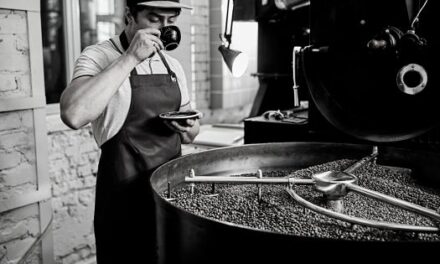“Winner, winner, chicken din-ner!”
Ugh. I rolled my eyes as he slurred it again. By now I’d lost count of just how many times he’d said this along with every other casino cliché that irks at a croupier like fingers on a chalkboard.
“Take that, Aaron”, he spat vitriolically. “You’ve got nothing. Nothing!”

During this period of my life I was working as a croupier again, late nights and weekends to support myselfthrough uni. The work itself could be quite a therapeutic escape from study as I’d submit my body to muscle-memory, and enough experience had made the calculations routine. Focus was still essential though. The one constant variable was the ever-changing crowd of personalities. Backgrounds were diverse, individuals could be explosive, and reactions to anything could be unpredictable.
In this environment, ensuring people enjoy themselves is imperative for business, and let me tell you; the true meaning of customer service is taking every dollar from seven furious ‘club members’ and having them thank you for it.
At this particular moment I was dealing to Marko, a jaded regular who loved to play blackjack but never seemed to leave the table with any money. Jimmy, his offsider sat to his left.
“Place your bets”, I opened up.
After a run of bad cards, Marko was becoming upset. “That’s crap”, he unloaded in different words. “You’re crap, Aaron.”
“Don’t be like that,” Jimmy came to my defence. “It’s not his fault. He’s just dealing the cards from a machine. You know he doesn’t have any effect on the game”.
“Yeah, yeah. I know. Sorry, Aaron.”
I thanked Jimmy with a nod and smiled to myself, knowing there was much more to it.
The customer is always right there.
At first, the casino business can seem completely different to any other. It is, after all, the only business in the world where the customer is not always right and you can get away with the odd ‘Yo Mama’ joke in ways that would never fly selling T-shirts at K-mart. Despite this, and perhaps even because of it, there are unique opportunities to develop and refine certain sales skills and customer service techniques that are universal. In many ways, I found these opportunities to be more beneficial than all of the other time I’ve spent in conventional industries before or since.
For instance, the first thing a ‘lumpy’(trainee) dealer is taught is that they cannot be seen or heard to be telling a customer what they should bet on or that they, the customer, should have an alcoholic drink. There is such a fine line to skirt between duty-of-care obligations and the commercial purpose of the business. So the dealer is restricted and cannot point to a vacant number on a roulette table and say to a customer, “You should put a chip on 26” in the same way a sales assistant would say, “You should try these shoes with that dress”.
To the business, this presents the challenge of needing to increase revenue without negatively impacting customers, to maximise income in a way that ensures the return and wellbeing of the consumer. Or, to use an old casino adage, “you can shear a sheep a hundred times, but you can only ever skin it once”.
So there exists a balance. Dealers are trained to identify warning-sign behaviours, but to employ advanced sales and customer service techniques when these behaviours are absent. The most obvious goal is to entertain, to keep the players at the table, and the most enjoyable dealers will accomplish this with boisterous personalities adding a little Vegas showmanship for razzle-dazzle here and there. Not everyone can pull this off though, and not everyone has to. Entertaining customer service doesn’t have to be loud and lively. In fact, misreading a customer’s demeanour can have the opposite effect to what’s intended. Some people enjoy themselves most sharing simple warm smiles and light-hearted company.
What about Marko? He’s been losing his shirt and clearly becoming more confrontational. The last thing he wants to see is a cocky young show-off flourish the cards with witty repartee. In his case, there are a dozen ways for me to keep him at the table or, comparatively, ‘in my shop’. In each instance the longer you can keep a customer in your presence, the greater likelihood there is of increasing their spend. In a casino, this will statistically result in the player returning chips they’ve been winning to this point or purchasing more once their initial supply has been exhausted. The primary strategy for dealing with Marko is simple. He’s already shown a tendency to be pacified by Jimmy and a willingness to agree with his friend. So it makes clear sense (and standard good customer service) to strike up a conversation with Jimmy. It could be about food, it could be about football, it could be about that time I took one to the nuts in primary school. It doesn’t matter, but I have to be careful here. Jimmy hasn’t been playing to this point, nor is he likely to. This conversation is not about entertaining Jimmy. My focus must not be to converse with him to the exclusion of Marko. Rather, by using Jimmy as a conduit, I can engage Marko on a more interactive level and influence the perception of his experience.
“I agree with you, Jimmy. The beer on tap here is delicious. Have you had one, Marko?”
“No way Sydney’s defence can beat Adelaide’s forward line, Jimmy. What do you think, Marko?”
“She got me right in the middle of the swing-set and left my little blue eyes glassy and sad. Ever had that happen to you, Marko?”
One of these is a strategically inserted promotion of the businesses other products.
One of these is a tactic to elicit a prolonged dialogue.
The other is just something that’s been making people laugh for nigh on thirty years now (it’s always funny when it isn’t you).
“Would you like chips with that?”
With customers remaining on-site and comfortably engaged, it’s time to roll out those sales techniques as you would in any other business. Appropriate opportunities and methods to do this will vary depending on the product, the customer, and the practiced ability of the vendor. At blackjack with Marko for instance, there are different propositions for this than there would be at a roulette table, just as there are nuanced subtleties applicable to the industries I’m involved in today and the position you are in right now. Regardless of this, the relevant concepts and techniques remain the same.
Perfect Pairs is a common side-bet available during every hand of blackjack. Asking, “Would anyone like a Perfect Pairs bet?” is the casino equivalent of McDonald’s famous old “Would you like fries with that?” The product itself exists as an opportunity to increase the average spend per transaction, the act of asking if a customer would like it is the simplest example of suggestive selling there is. The mere mention of it will trigger a favourable response in many customers.
Remember that vacant number 26 on the roulette table? The dealer mustn’t instruct a customer to put a chip on it, but an observation can be announced. “No one has anything on 26” is an alert that lingers as a call for customers to make a decision on their own. Of course some will respond affirmatively, choosing to place a chip on 26 seemingly of their own free will.
Let’s transfer this to a more conventional sales environment. How about that sales assistant who said “You should try these shoes on with that dress”. To a customer who may be sceptical of the sales assistant’s motives, a less overt statement may have a more favourable sales outcome.
“I wonder what these shoes would look like with that dress.”
Back in the casino, there are countless more examples to be related regarding add-on sales, up-selling, associate-selling and suggestive selling techniques, but for the sake of word-count here let’s skip to the end of a transaction to observe something clever that elite dealers will do to keep your dollars in their float.
“I’ll take a tiger, thanks”
Depending on your frequency at the gaming tables, you may or may not have noticed different people receiving the same pay-out in different denominations. The most common example is for a dealer to give one person a black $100 chip (a ‘tiger’) yet hand another person their equal winnings in the form of twenty $5 chips. Why? Because a good dealer knows that a single $100 chip will go straight into a player’s pocket, whereas the equivalent value in $5 chips will remain in-play on the table with greater chance of it all ending up back in the dealer’s float.
On a smaller scale, this is why you may never be given a two-dollar coin as change at any Aussie pub with pokies. Instead, two shiny one dollar coins will drop into your hand simply because it costs no extra time or money for them to do so, yet what do you think a large proportion of people choose to do with those coins?
Take this concept further out into the world and see it fit the way some finance companies will present a weekly repayment figure to prospective borrowers even when the scheduled terms are to be structured monthly. It’s smoke-and-mirrors depending on your ethical view, but the psychological intention is the same: the lower a figure appears, the easier it is to transact.
Scratching the surface, these techniques are all tweaked for context but the concepts are nothing new. For me, I like to look back once in a while to identify and value such past experiences and skillsets, drawing on them to relate and apply when beneficial to current tasks.
Take a look back at your own path. What can you borrow from your own unique past experiences and how can they contribute positively to your service delivery and sales process today?
I can’t always find a way to relate dealing cards to Marko to everything I do now, but I always remember keeping him at the table by treating him well and affecting the game with commonly applicable sales techniques.



















